Planning your own trip? Prepare for your trip
Use Rough Guides' trusted partners for great rates
Travel advice for Germany
From travel safety to visa requirements, discover the best tips for visiting Germany
Plan and book your private, tailor-made tour with vetted local experts
Germany is packed with castles – not just fairytale towers, but fortresses, royal residences, and grand palaces built to show off serious power. For centuries, this was a fragmented land of duchies and city-states, each ruled by nobles competing for status. The result is a legacy of bold architecture, from medieval hilltop strongholds to over-the-top Baroque palaces. A few made the UNESCO list – others just look the part. This list cuts through the clutter to bring you the best castles in Germany – the ones that are worth seeing.
With more than 20,000 castles scattered across the country, narrowing down the best castles in Germany is no easy task. Some are medieval fortresses perched high above river valleys, others are royal palaces built to impress visiting dignitaries – or just outdo the neighbours. While many have fallen into ruin, dozens are still standing tall, restored and open to visitors.
The most famous castle in Germany is Neuschwanstein – and yes, it’s worth seeing, even if it’s packed. But it’s not the only one. Castles like Burg Eltz, Hohenzollern, and Wartburg offer just as much drama, minus the crowds. Others, like the Residenz in Würzburg or Augustusburg in Brühl, show off the grandeur of the Baroque period in full force.
If you’re planning a Germany itinerary, it’s worth mixing in a few castle stops. Many are within reach of major cities like Munich, Cologne, or Frankfurt. They combine well with vineyard visits, river cruises, or scenic drives. For architecture, history, and atmosphere, these castles are some of the best places to visit in Germany, and are worth going out of your way for.

Palace Brühl © GNTB/Florian Trykowski
A showpiece of Rococo excess, Schloss Augustusburg was the main residence of the prince-archbishops of Cologne. Completed in 1768, it’s one of the finest early Rococo buildings in Germany – all lemon-yellow walls, grand symmetry, and mind-bending interior detail. Inside, Bavarian architect François de Cuvilliés let loose with lavish stucco, gold accents, and sculpted flourishes. The real star, though, is Balthasar Neumann’s sweeping staircase – a theatrical masterpiece of marble, jasper, painted ceilings, and carved caryatids.
The French-style gardens behind the palace are equally meticulous, laid out with mirror pools, clipped hedges, and long axial paths. One of them leads to Falkenlust, a compact 18th-century hunting lodge used for falconry. It’s more modest but full of charm, especially the grotto-like chapel decorated with shells and sea motifs.
Brühl is just 20 minutes by train from Cologne. From the station, it’s a 10-minute walk to Augustusburg. Falkenlust is a further 20 minutes on foot through the gardens.
Spring to early autumn is best for walking the grounds. In winter, interiors remain open, but the gardens lose their impact.

Würzburg: Residenz Palace and garden © GNTB/Francesco Carovillano
The Würzburg Residenz isn’t just another Baroque palace – it’s one of the most extravagant castles in Germany, and a UNESCO World Heritage site for good reason. Built for the prince-bishops of Würzburg and finished in 1770, this monumental residence mixes French elegance with Viennese flair and German craftsmanship. Its creators brought in some of Europe’s best minds, including architect Balthasar Neumann and painter Giovanni Battista Tiepolo, whose massive ceiling fresco still stuns today.
Inside, it’s a maze of marble staircases, stuccoed salons, and chandelier-lit reception halls. The lavish style even earned its name: Würzburg Rococo. Don’t rush – this place is made for slow wandering.
Out back, the Hofgarten is a quiet contrast to the palace’s grand interiors. Its manicured paths wind past fountains, fruit trees, and pergolas – a peaceful break from the city outside.
Würzburg is well connected by train, about 1 hour from Frankfurt. The Residenz is a short walk from the station, near the city center.
Spring through early autumn is ideal for the gardens. But even in winter, touring the Residenz itself is still one of the best things to do in Germany for anyone interested in Baroque architecture and courtly life.
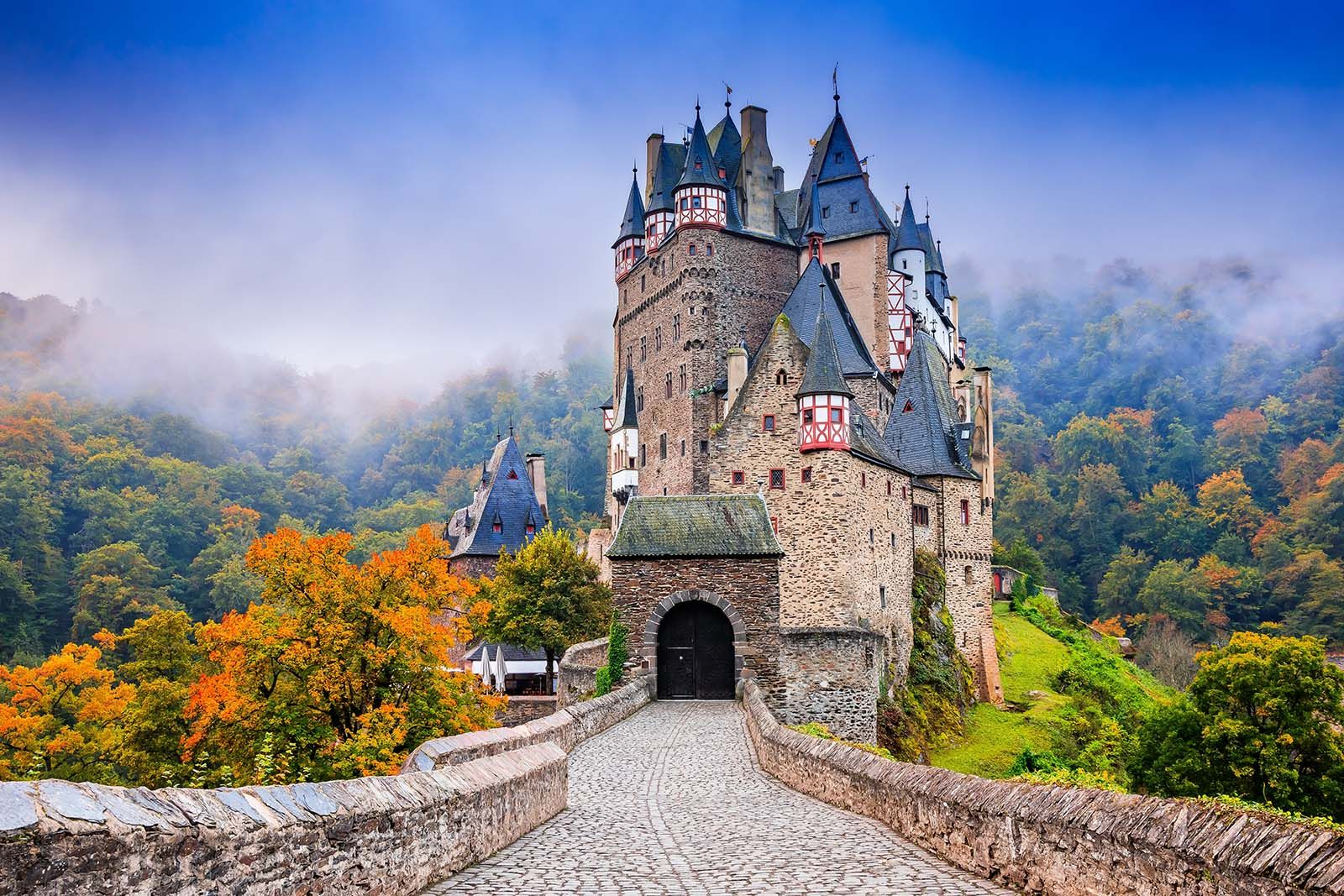
Eltz Castle or Burg Eltz. Medieval castle on the hills above the Moselle River. Rhineland-Palatinate Germany © Shutterstock
If you're only visiting one medieval castle in Germany, make it Burg Eltz. This turreted fortress has been perched on a forested ridge above the Moselle River for over 850 years – and it's still owned by the same family that built it. Unlike many other castles, Eltz was never destroyed, which means what you see today is the real deal: thick stone walls, timbered gables, and rooms filled with original furnishings, armor, and priceless art.
Inside, guided tours take you through lavish bedrooms, Gothic halls, and a treasure chamber packed with gold and silver objects. Outside, the whole place looks like something a fantasy novel would dream up, especially when mist hangs over the surrounding woods.
The nearest train station is Moselkern. From there, it’s a scenic 90-minute hike to the castle. You can also drive and park closer, followed by a short shuttle ride or 15-minute walk.
Open from April to early November. Mornings or late afternoons are best to avoid crowds, especially in summer.
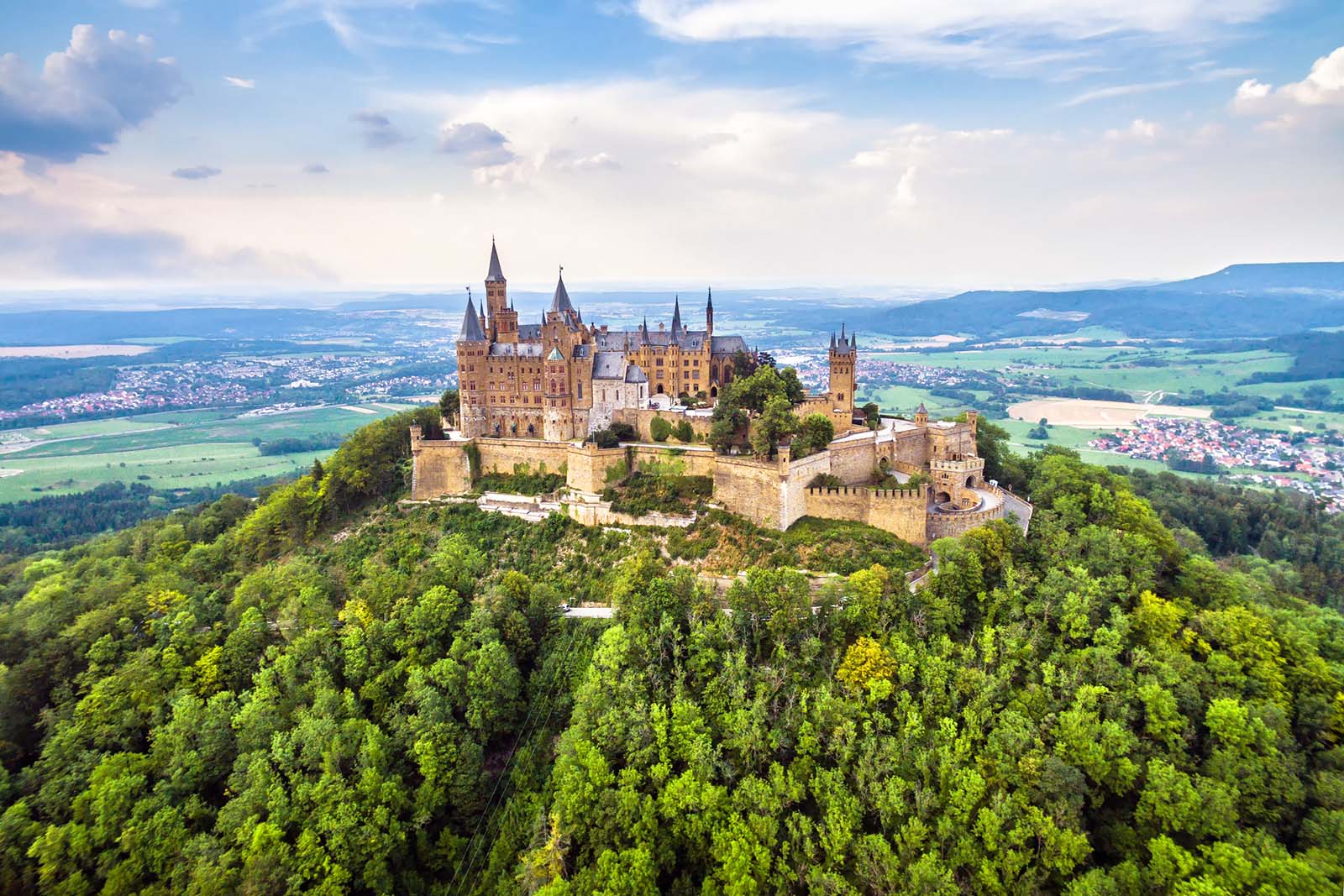
Hohenzollern Castle on mountain top, Baden-Wurttemberg, Germany © Shutterstock
Perched dramatically on a hilltop in the Swabian Alps, Hohenzollern Castle looks like it was pulled straight from a fantasy film – and it kind of was, having inspired scenery in The Monuments Men. The current structure is a 19th-century rebuild, but don’t let that put you off. It’s still packed with history and linked to one of Germany’s most powerful dynasties: the Hohenzollerns, who ruled Prussia and later the German Empire.
Inside, the castle is a mix of Neo-Gothic flourishes, stained glass, family relics, and royal memorabilia – including Frederick the Great’s uniform. The views are just as much of a draw. On clear days, you can see across the lowlands of Baden-Württemberg to the Black Forest and beyond.
This one’s more imperial pageantry than medieval grit, but the setting and architecture make it unmissable.
The closest town is Hechingen, around 1 hour by train from Stuttgart. From there, take a shuttle bus or taxi up to the castle.
Clear days between April and October are ideal. Fog sometimes swallows the view – and half the magic – in winter.

Wartburg Castle, Eisenach, Germany
Wartburg Castle is one of Germany’s most important historical sites – and a rare case where the legends match the location. Founded in the 11th century, it’s a real medieval fortress, complete with timber galleries, high towers, and thick stone ramparts. It’s also where Martin Luther hid out in 1521, under threat of execution, and translated the New Testament into German. That alone gives it serious historical weight.
Inside, the castle is part museum, part time capsule. Highlights include the richly decorated Festsaal (banquet hall), the private quarters used by Luther, and a Romanesque chapel. Some of the castle was restored in the 19th century, but it still retains a medieval atmosphere without tipping into kitsch.
This isn’t just another hilltop lookout – it’s where religion, language, and politics collided in a way that shaped German identity.
Take the train to Eisenach, which is well connected across central Germany. From the station, it’s a steep 30-40 minute walk or a short bus or taxi ride up to the castle.
Spring through autumn offers the best views and hiking weather. It’s open year-round, but winter can be icy and gray.

The castle (castle ruin) in Heidelberg, Baden Wuerttemberg, Germany © Shutterstock
Heidelberg Castle isn’t perfectly preserved – and that’s exactly what makes it stand out. Sitting high above the Neckar River, this half-ruined Renaissance palace is one of the best castles in Germany for atmosphere, layered history, and sheer scale. Lightning strikes, war, and neglect left it in ruins by the 18th century, and it’s been looming over the old town ever since.
First built in the 13th century, the castle became a lavish residence for the Electors Palatine. Today, you can explore the surviving walls, Renaissance façades, and viewing terraces overlooking the red roofs of Heidelberg. There’s also a museum covering everything from royal life to pharmacy history, and an absurdly oversized wine barrel in the cellar – more stunt than storage.
Take the train to Heidelberg, then walk or ride the funicular from Kornmarkt to the castle.
Best in spring or early autumn. Summer gets busy, but the open-air courtyards and views make up for it.
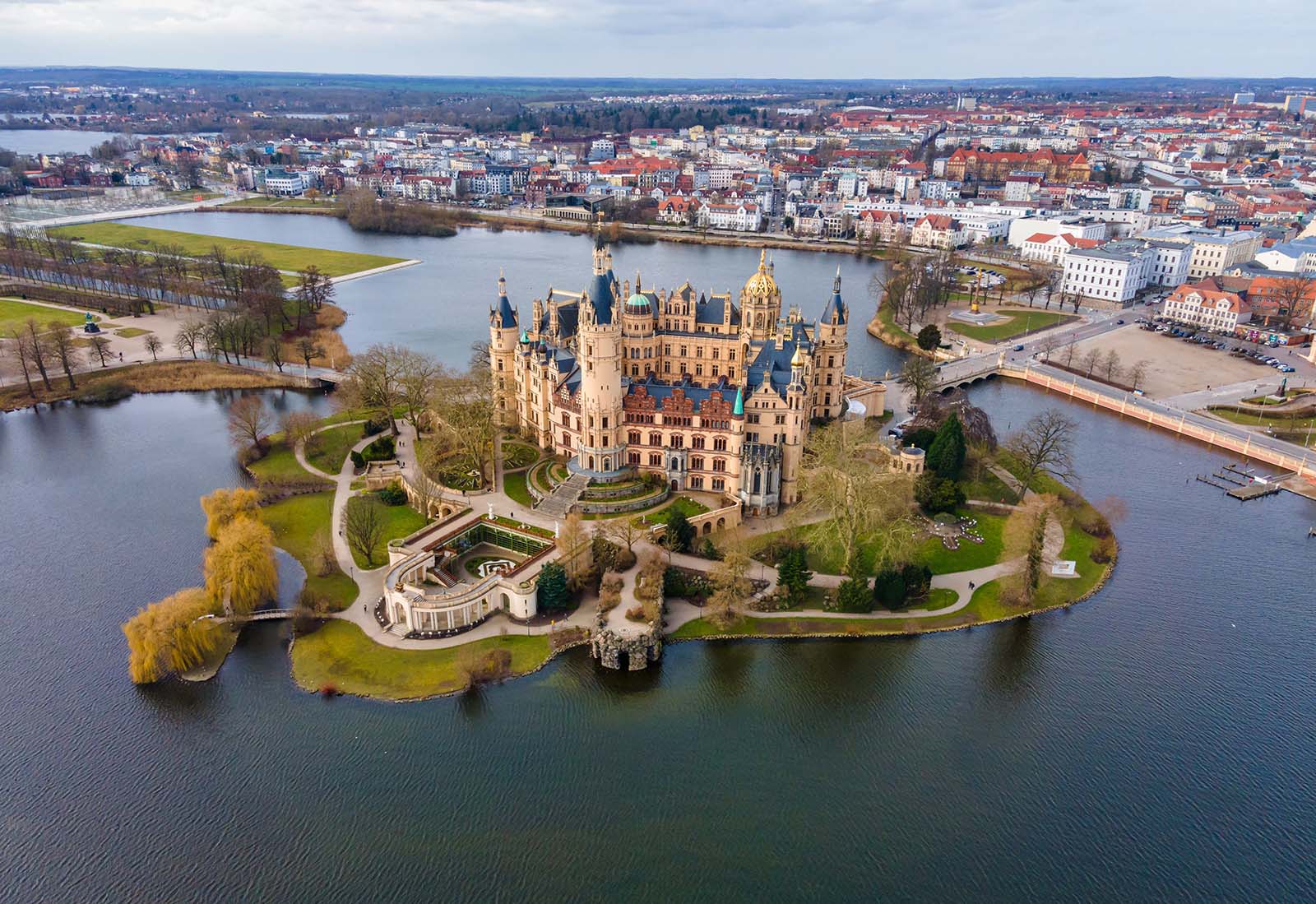
Aerial view of Castle building Schwerin (Germany) © Shutterstock
Set on its island in the middle of a lake, Schwerin Castle looks more like a fantasy palace than a fortress – all golden spires, turrets, and lakeside reflections. It was rebuilt in the 19th century in a Neo-Renaissance style, but the site has been fortified since at least the 10th century. For centuries, this was the seat of the grand dukes of Mecklenburg, and it still feels like a royal residence.
The interiors are full of classic fairytale appeal – gold trim, velvet-lined halls and a throne room straight out of a storybook. Kids can follow the castle’s own legend of the Petermännchen, a tiny ghost said to haunt the halls. Outside, the gardens are ideal for a stroll or a run around, and the island setting adds to the sense of adventure. It’s a great stop if you’re exploring Germany with kids, especially younger ones.
Take a train to Schwerin from Hamburg (around 90 minutes). From the station, it’s a 15-minute walk to the castle.
Best from May to September, when the gardens are in bloom and the lakeside setting really shines.
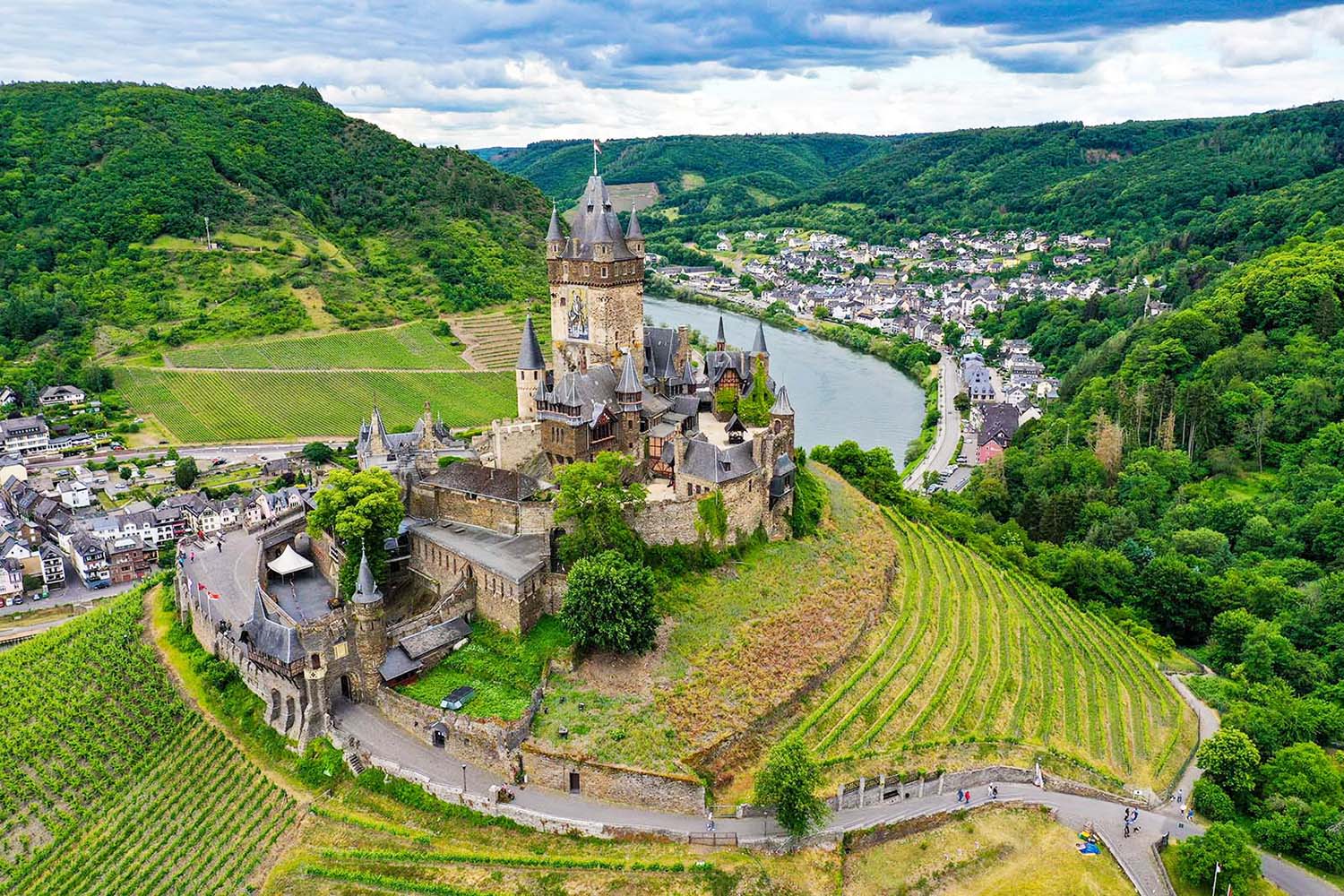
Cochem Castle above the winding Mosel river © Shutterstock
High above the Moselle River, Cochem Castle ticks every box for classic castle drama: towers, battlements, turrets and a commanding view of the valley below. It looks medieval – and the original structure was – but what you see today is a 19th-century reconstruction in full Gothic Revival style. That doesn’t make it any less fun to visit. In fact, it’s one of the most popular German castles for good reason.
Guided tours take you through ornate dining rooms, knight’s halls and armories filled with antique weapons and furniture. The real highlight, though, is the setting. The town of Cochem is all half-timbered charm, and the castle rises right above it – an easy walk if you don’t mind hills.
There are regular themed events in summer, including medieval banquets with costumed performers. It can lean a bit touristy, but the atmosphere makes it worth it.
Take a regional train from Koblenz (about 40 minutes) or Trier (just over 1 hour) to Cochem station. From there, it’s a 20-minute uphill walk to the castle or a short ride on the local shuttle.
April to October is best, when tours run daily and the valley is at its most scenic.
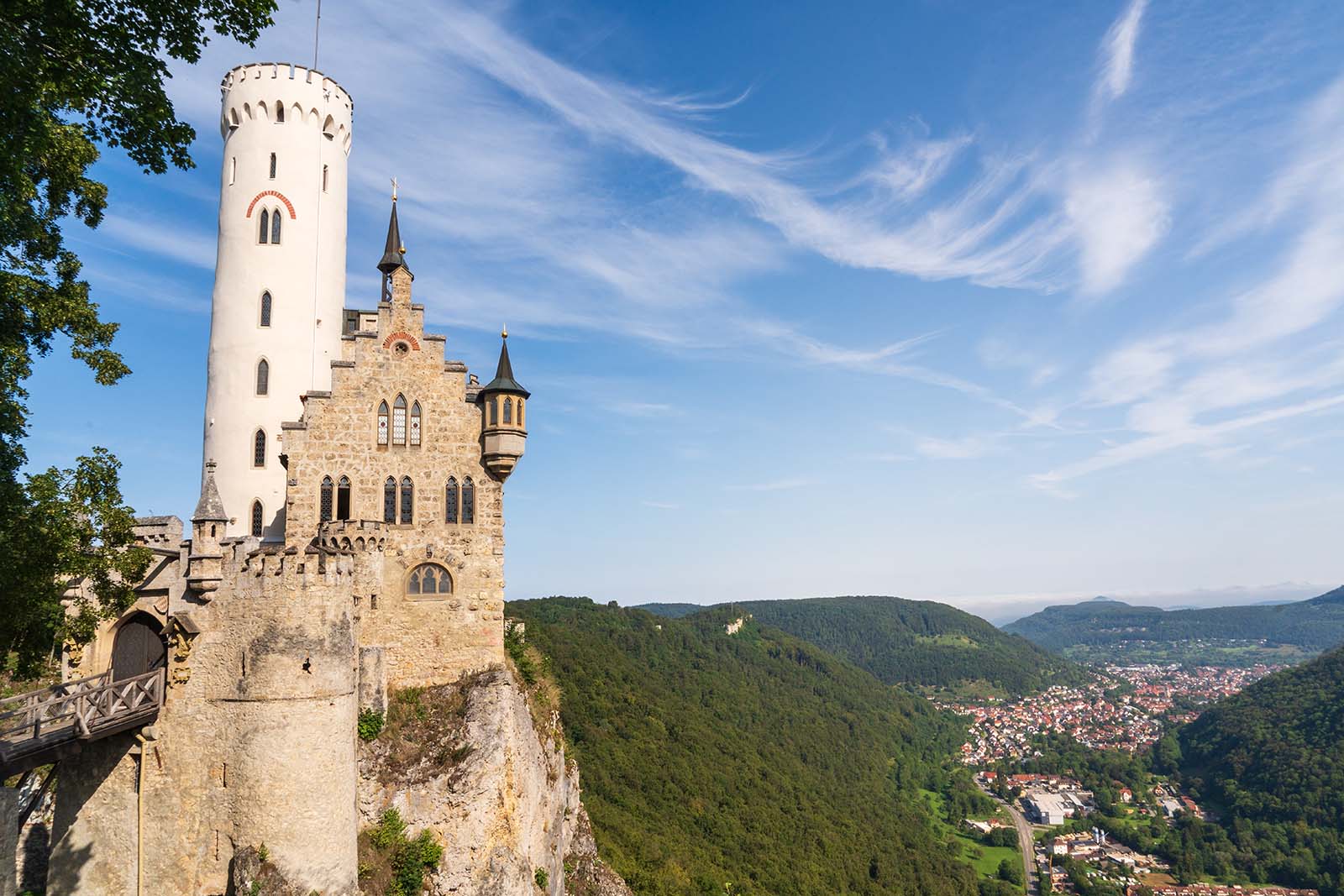
The Lichtenstein Castle, in Baden-Württemberg © Shutterstock
Lichtenstein Castle looks like something out of a storybook – perched dramatically on a rocky cliff, with a narrow bridge connecting it to the mainland. Built in the mid-19th century, it’s not a medieval fortress but a romantic fantasy inspired by the novel Lichtenstein by Wilhelm Hauff. That doesn’t make it any less striking – it’s one of the most photogenic castles in southern Germany, and a solid detour if you’re planning a trip to Germany that includes the Swabian Jura region.
The interiors are compact but rich with detail: stained glass, wood-panelled halls, and collections of weapons and armor. It’s privately owned but open for guided tours, which are short and to the point. The clifftop setting is the real showstopper, especially in autumn when the forests below turn golden.
It’s less famous than nearby Hohenzollern, but that just means fewer tour buses and a more relaxed experience.
The nearest town is Reutlingen. From there, take a bus or taxi to Honau, then hike 30 minutes uphill to the castle.
Open March to November. Clear days offer the best views – and fewer crowds on weekday mornings.
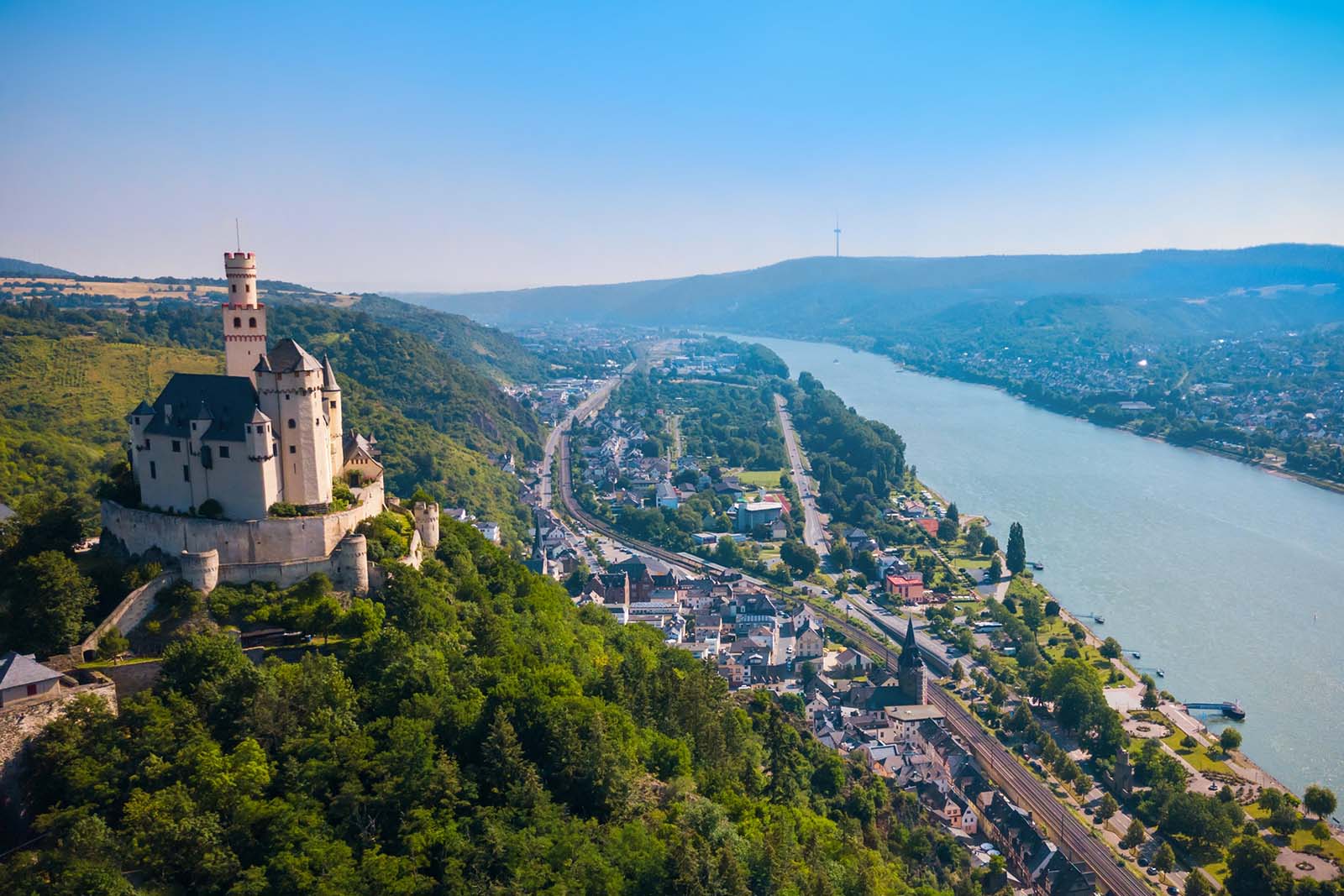
Marksburg castle, Germany © Shutterstock
Marksburg Castle is one of the few hilltop castles along the Rhine that was never destroyed – and it shows. Perched above the town of Braubach, it’s a proper medieval fortress: all thick walls, winding stairways, and defensive towers. Built in the 12th century and expanded over time, it was designed for protection, not decoration, and that’s what makes it stand out.
Unlike the romantic reconstructions found elsewhere, Marksburg gives you the raw, functional side of castle life. Guided tours take you through everything from the knights’ hall and chapel to the kitchens, dungeons, and even a medieval toilet. The armory and wine cellar are highlights, too.
If you're hunting for authenticity, this is easily one of the best castles in Germany – no fairytale gloss, just centuries of solid stone and history.
Take the train to Braubach from Koblenz (about 30 minutes). From the station, it’s a steep 15-20 minute walk up to the castle.
Open year-round, but April to October offers longer hours and better weather for the climb.
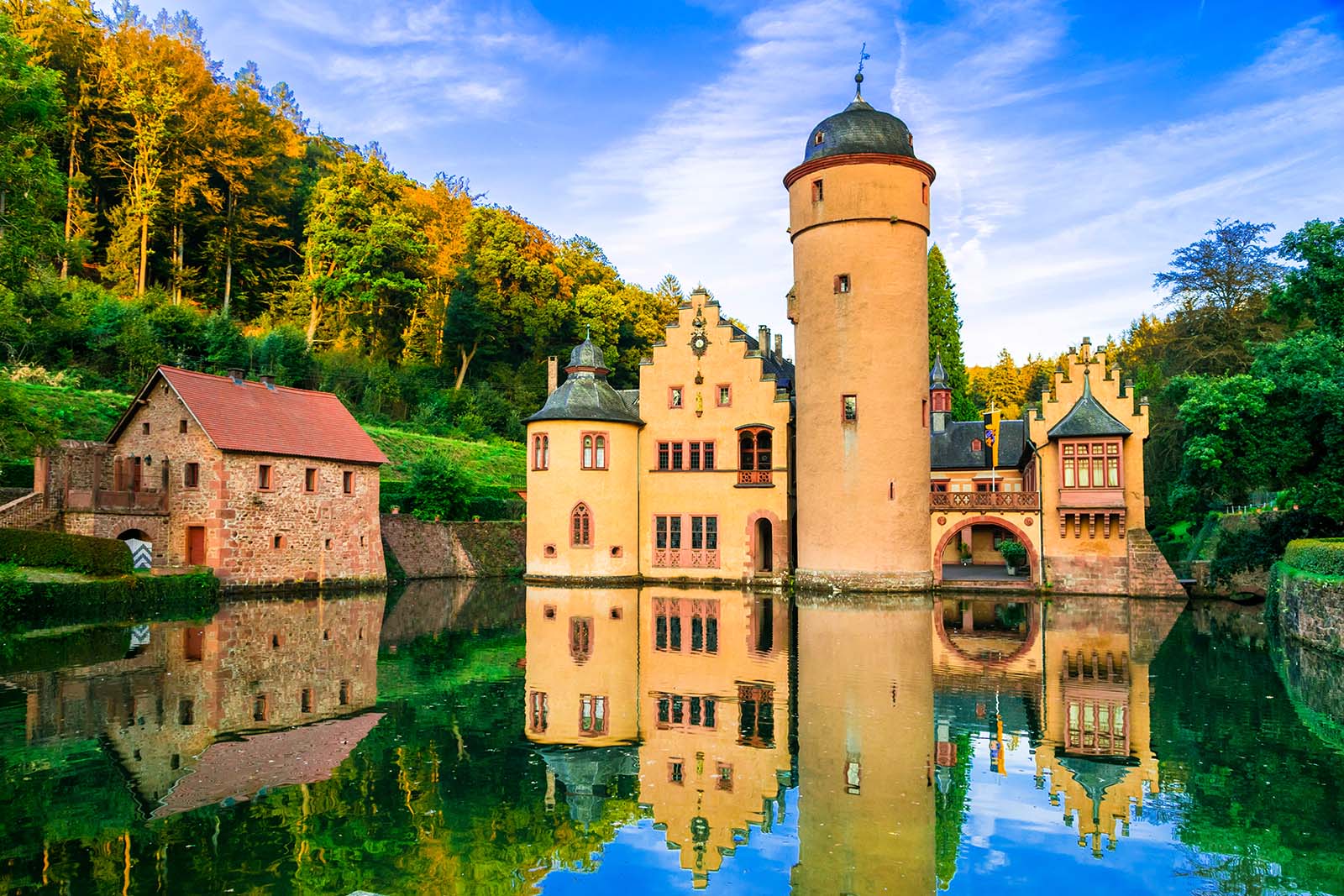
Mespelbrunn schloss in Germany © Shutterstock
Tucked away in a quiet forest between Frankfurt and Würzburg, Mespelbrunn Castle is more moor than mountain. This water castle sits low and secluded, surrounded by still ponds and leafy trees, making it feel more like a hidden retreat than a fortress. Originally built as a fortified house in the 15th century, it was gradually transformed into a Renaissance residence, and it's still privately owned by the same noble family.
The size is modest, but that’s part of the appeal. Guided tours give you access to furnished rooms, portraits of past lords and ladies, and a library with centuries-old volumes. It’s compact, calm, and far less touristy than some of the bigger names.
The castle also starred in the classic German film The Spessart Inn (1958), which made it famous across the country, but international visitors still often miss it.
The nearest train stations are Aschaffenburg or Heigenbrücken. From there, you’ll need a taxi or rental car – it’s about a 20-minute drive through forested backroads.
Open from mid-March to early November. It’s at its best in late spring or early autumn, when the grounds are quiet and green.
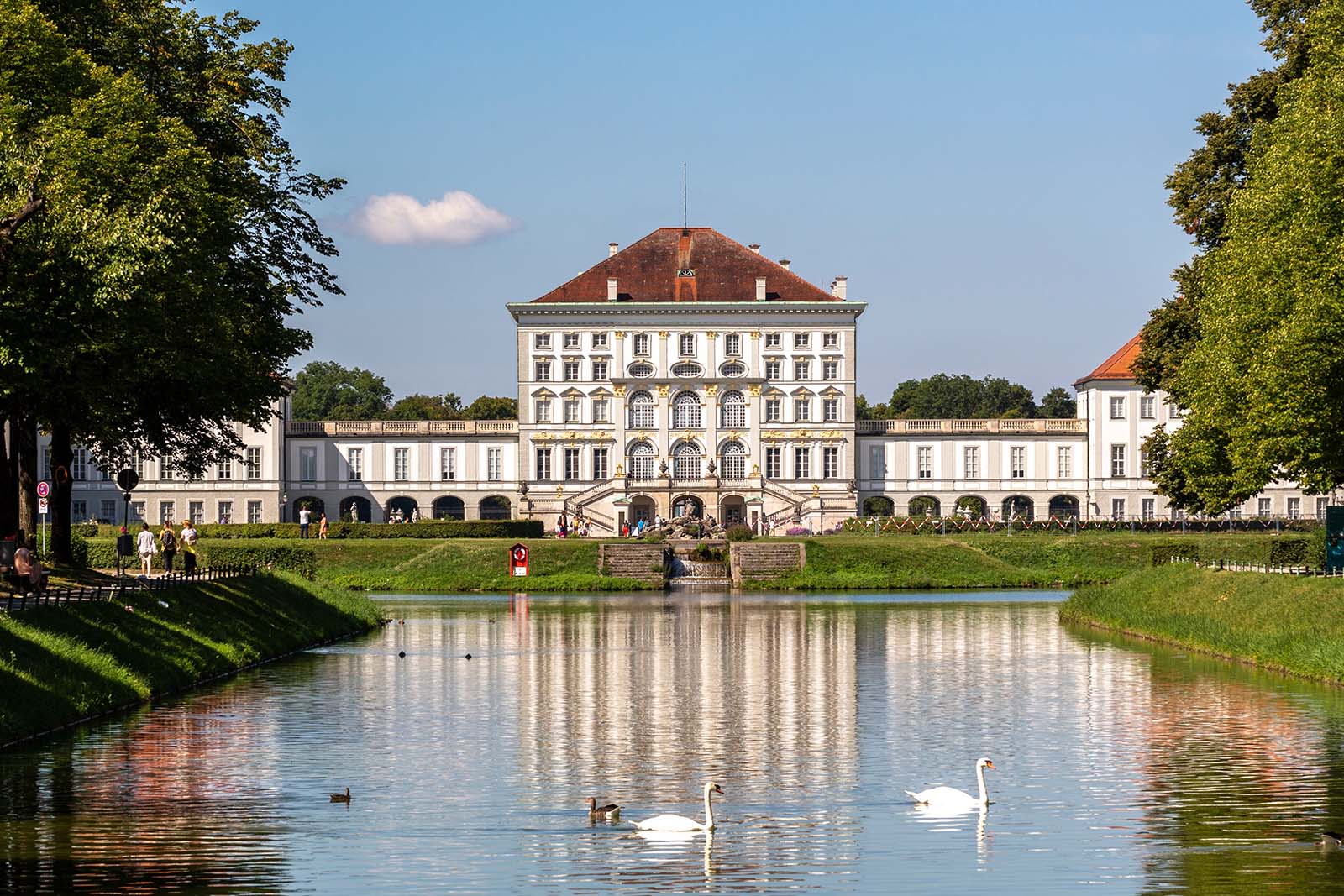
Nymphenburg Palace in Munich © Shutterstock
More palace than fortress, Nymphenburg was the summer home of Bavaria’s ruling Wittelsbach family – and it still feels like royalty could walk through the doors at any moment. Located just outside central Munich, this massive complex combines ornate Baroque interiors with vast formal gardens, a canal, and even a collection of royal carriages.
The main hall is a standout, with frescoed ceilings, chandeliers, and marble columns framing one of the most dramatic entrances in Bavaria. You can also visit the royal apartments, the porcelain museum, and the hunting lodge-style pavilions scattered across the park. Despite its size, the place rarely feels crowded, especially if you’re willing to wander off the main paths.
If you’re into architecture, court life, or over-the-top design, this is one of the German castles that delivers all of that, without needing a hilltop or a moat.
Take tram 17 from central Munich to Schloss Nymphenburg. It’s about 25 minutes from the city center.
Spring to early autumn is ideal for seeing the gardens in full bloom, but the interiors are open all year.

Wernigerode Castle in the Harz mountains, Germany © Shutterstock
Overlooking the half-timbered town of Wernigerode and the northern edge of the Harz Mountains, Wernigerode Castle is a hilltop retreat with serious fairytale vibes. Originally a medieval fort, it was transformed in the 19th century into a romantic residence by the local counts, complete with turrets, sweeping staircases, and lavish rooms designed to impress.
The interiors are surprisingly intact and fully furnished, offering a detailed look at aristocratic life in the late 1800s. From grand salons to private studies, it’s all about atmosphere. One wing also hosts temporary exhibitions on everything from local history to photography.
What sets this one apart is the view – on a clear day, you can see across the Harz and even spot the Brocken, the region’s highest peak. It’s especially dramatic in autumn, when the forest below glows with color.
Take the train to Wernigerode (about 3 hours from Berlin with one transfer). From the town center, it’s a 20-minute uphill walk, or you can hop on the tourist train.
Open year-round, but best in autumn for views and fewer crowds.
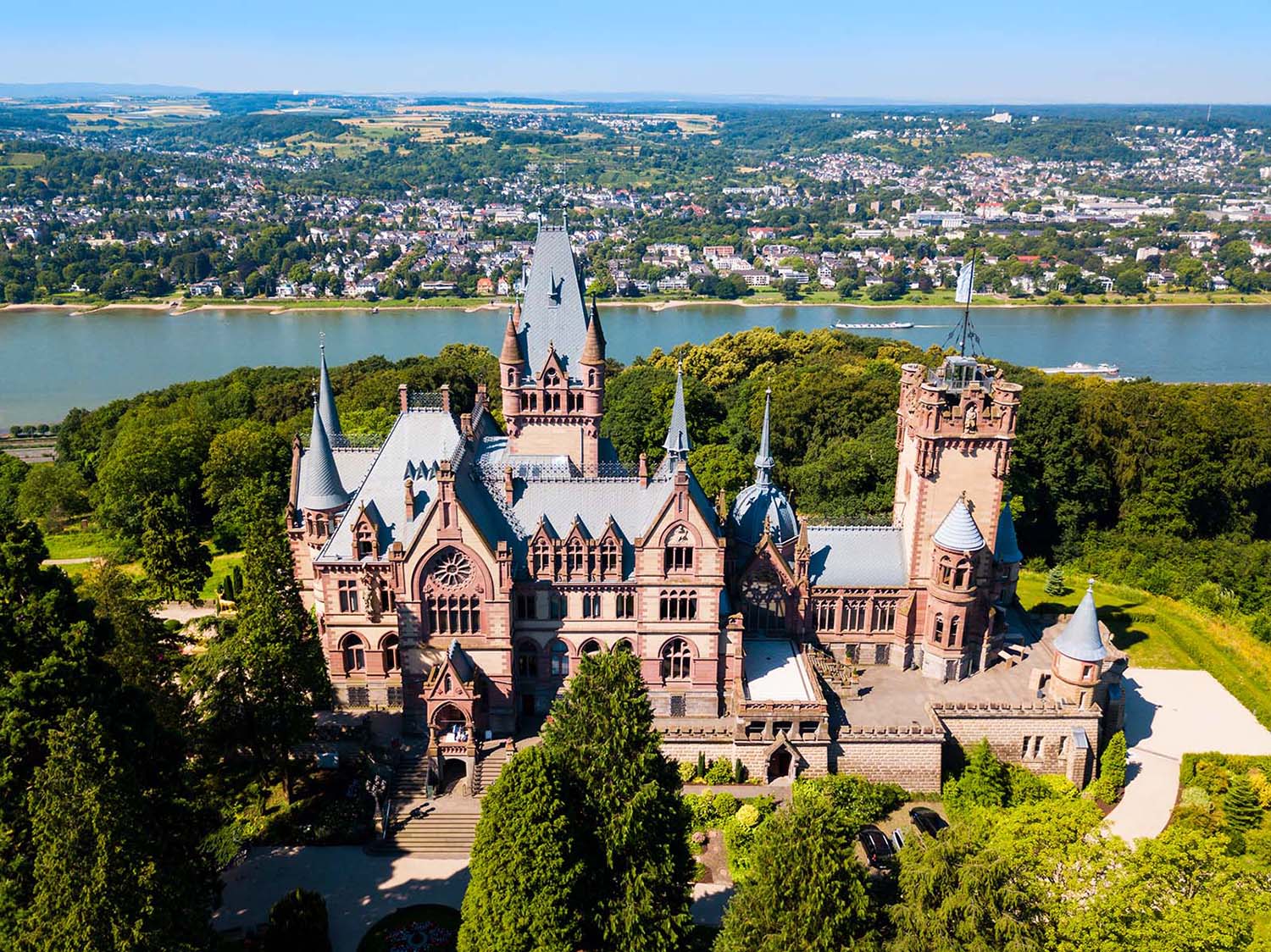
Schloss Drachenburg Castle is a palace in Konigswinter on the Rhine river near the city of Bonn in Germany © Shutterstock
Built in the late 19th century by a wealthy banker with a taste for grandeur, Schloss Drachenburg isn’t medieval, but it pulls off the illusion well. Perched above the Rhine in the Siebengebirge hills, it’s a Gothic Revival fantasy of spires, balconies, and stained glass – more showpiece villa than defensive stronghold, but still packed with character.
The interiors are lavish in a way only 19th-century money can manage: grand halls, ornate ceilings, and over-the-top murals that blend myth, religion, and nationalism. One floor serves as a museum on the building’s odd history – including its time as a Nazi training school and later, a ruin. The full restoration only finished in the 2000s.
Getting there is part of the fun. You can hike up through forest trails or ride the historic Drachenfelsbahn, Germany’s oldest cog railway. Either way, the panoramic views over the Rhine are worth it.
Take a train to Königswinter from Bonn or Cologne. From there, hike up (30-40 minutes) or ride the Drachenfelsbahn to the summit.
Best from spring through early autumn, when the weather’s clear and the views are at their best.

Neuschwanstein Castle in Bavaria, Germany © VOJTa Herout/Shutterstock
Let’s be honest – Neuschwanstein Castle is a tourist magnet. But it’s also one of the best castles in Germany, and easily the most iconic. Built in the late 19th century by the reclusive King Ludwig II, it was never intended for defence. Instead, it was designed as a fantasy retreat – part medieval homage, part theatrical set.
Set high in the Bavarian Alps above Hohenschwangau, Neuschwanstein looks like it belongs in a fairy tale (or a Disney logo). The interiors are just as surreal: ornate woodwork, frescoes of mythical scenes, and a man-made grotto built inside the castle. Ludwig only lived here for a short time before his mysterious death, but the castle has drawn crowds ever since.
Yes, it’s busy – but it’s also unforgettable, especially if you catch it in the early morning light or dusted with snow.
Take a train to Füssen from Munich (about 2 hours), then a local bus to Hohenschwangau. From there, it’s a steep 30-minute walk or a short shuttle ride.
Spring and autumn offer smaller crowds and clear views. Book tickets in advance – it sells out fast.
written by
Olga Sitnitsa
updated 01.08.2025
Online editor at Rough Guides, specialising in travel content. Passionate about creating compelling stories and inspiring others to explore the world.
Use Rough Guides' trusted partners for great rates
From travel safety to visa requirements, discover the best tips for visiting Germany
Discover Germany's most captivating stories